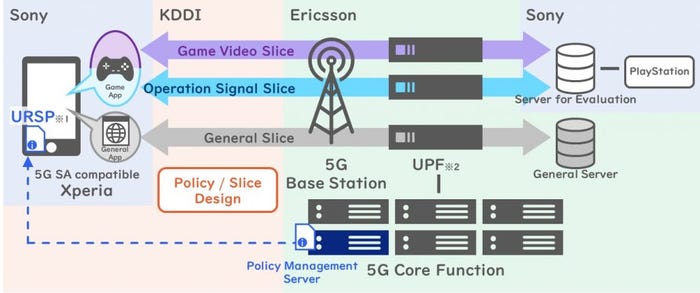For some applications, one network slice is never enough
Japan's KDDI and Sony have demonstrated how a single application can make use of more than one network slice.
December 19, 2022

Japan’s KDDI and Sony have demonstrated how a single application can make use of more than one network slice.
There have been examples of devices connecting to multiple network slices before, using what’s called user equipment route selection policy (URSP), but each slice was set up to cater to a separate application. KDDI and Sony claim this is the first time that URSP has been used to enable one app to make use of more than one slice.
Why is this useful? Well, while a lot of apps – like Netflix, for example – would benefit from a single slice optimised for reliable video delivery, others are a little more complicated. For example, a remote-controlled vehicle like a drone would need to receive control inputs from the user, and send live video back so they can see what’s going on. Clearly then, a connection that is tailored to optimise both of those functions would have its uses.
Similarly, in KDDI and Sony’s demonstration, they used URSP and 5G standalone (SA) core networking equipment supplied by Ericsson to show how a game played on an Xperia smartphone can use one slice for the video signal, and another for the controls. As the diagram below shows, in addition to the two slices, a ‘general’ slice is also maintained for background connectivity.

“It confirmed that a game application can concurrently use multiple network slices with different properties for image data and control data,” said a joint statement from KDDI and Sony, with the companies insisting that the result was smoother gameplay.
“This significant achievement with KDDI, an important customer of ours, and Sony, a key partner, paves the way for all sorts of applications in network slicing,” said Chris Houghton, SVP and head of market area Northeast Asia, in a separate statement from Ericsson. “We will continue to support our customers and partners in Japan to monetise their networks by delivering new value and services for end users.”
Speaking of monetising, ABI Research predicts 5G network slicing revenue will weigh in at $24 billion by 2028, compared to $309 million this year.
However, there are of course a few hurdles to overcome before we’re all enjoying smooth graphics and gameplay courtesy of multiple concurrent network slices, not the least of which is that it requires a 5G standalone network and compatible device.
Ericsson cited Global mobile Suppliers Association (GSA) stats in its most recent Mobility Report that show 35 CSPs and counting have deployed or launched 5G SA networks. Moreover, Ericsson claims more than half of all announced 5G devices globally are compatible with 5G SA. While this represents encouraging progress, the early users will more than likely be large enterprises deploying slices on their own, campus-wide private networks. Mass market uptake is probably still some way off.
Get the latest news straight to your inbox. Register for the Telecoms.com newsletter here.
About the Author
You May Also Like










.png?width=300&auto=webp&quality=80&disable=upscale)


_1.jpg?width=300&auto=webp&quality=80&disable=upscale)